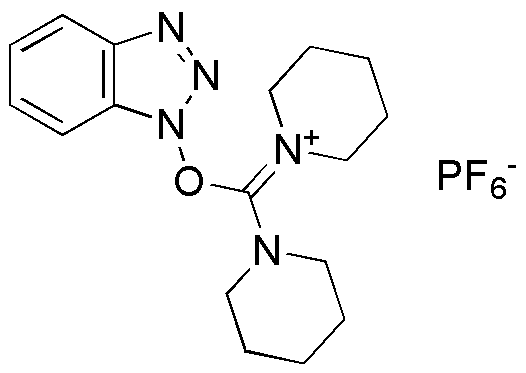O-(Benzotriazol-1-yl)-N,N,N',N'-bis(pentamethylene)uronium hexafluorophosphate is widely utilized in research focused on:
- Corrosion Inhibition: This compound serves as an effective corrosion inhibitor in metalworking fluids, helping to protect metals from oxidative damage, which is crucial in industries like automotive and aerospace.
- Photostabilizers: It is used in the formulation of photostabilizers for plastics and coatings, enhancing their durability against UV light, thus extending the lifespan of products in construction and consumer goods.
- Biochemical Research: Researchers employ this chemical in biochemical assays, particularly in studying enzyme activity and protein interactions, providing insights that are essential in drug development.
- Electrochemical Applications: The compound is applied in electrochemical sensors, improving sensitivity and selectivity, which is beneficial for environmental monitoring and food safety testing.
- Polymer Chemistry: It is utilized in the synthesis of advanced polymers, offering unique properties such as improved thermal stability and mechanical strength, which are advantageous in electronics and materials science.
General Information
Properties
Safety and Regulations
Applications
O-(Benzotriazol-1-yl)-N,N,N',N'-bis(pentamethylene)uronium hexafluorophosphate is widely utilized in research focused on:
- Corrosion Inhibition: This compound serves as an effective corrosion inhibitor in metalworking fluids, helping to protect metals from oxidative damage, which is crucial in industries like automotive and aerospace.
- Photostabilizers: It is used in the formulation of photostabilizers for plastics and coatings, enhancing their durability against UV light, thus extending the lifespan of products in construction and consumer goods.
- Biochemical Research: Researchers employ this chemical in biochemical assays, particularly in studying enzyme activity and protein interactions, providing insights that are essential in drug development.
- Electrochemical Applications: The compound is applied in electrochemical sensors, improving sensitivity and selectivity, which is beneficial for environmental monitoring and food safety testing.
- Polymer Chemistry: It is utilized in the synthesis of advanced polymers, offering unique properties such as improved thermal stability and mechanical strength, which are advantageous in electronics and materials science.
Documents
Safety Data Sheets (SDS)
The SDS provides comprehensive safety information on handling, storage, and disposal of the product.
Product Specification (PS)
The PS provides a comprehensive breakdown of the product’s properties, including chemical composition, physical state, purity, and storage requirements. It also details acceptable quality ranges and the product's intended applications.
Certificates of Analysis (COA)
Search for Certificates of Analysis (COA) by entering the products Lot Number. Lot and Batch Numbers can be found on a product’s label following the words ‘Lot’ or ‘Batch’.
*Catalog Number
*Lot Number
Certificates Of Origin (COO)
This COO confirms the country where the product was manufactured, and also details the materials and components used in it and whether it is derived from natural, synthetic, or other specific sources. This certificate may be required for customs, trade, and regulatory compliance.
*Catalog Number
*Lot Number
Safety Data Sheets (SDS)
The SDS provides comprehensive safety information on handling, storage, and disposal of the product.
DownloadProduct Specification (PS)
The PS provides a comprehensive breakdown of the product’s properties, including chemical composition, physical state, purity, and storage requirements. It also details acceptable quality ranges and the product's intended applications.
DownloadCertificates of Analysis (COA)
Search for Certificates of Analysis (COA) by entering the products Lot Number. Lot and Batch Numbers can be found on a product’s label following the words ‘Lot’ or ‘Batch’.
*Catalog Number
*Lot Number
Certificates Of Origin (COO)
This COO confirms the country where the product was manufactured, and also details the materials and components used in it and whether it is derived from natural, synthetic, or other specific sources. This certificate may be required for customs, trade, and regulatory compliance.


